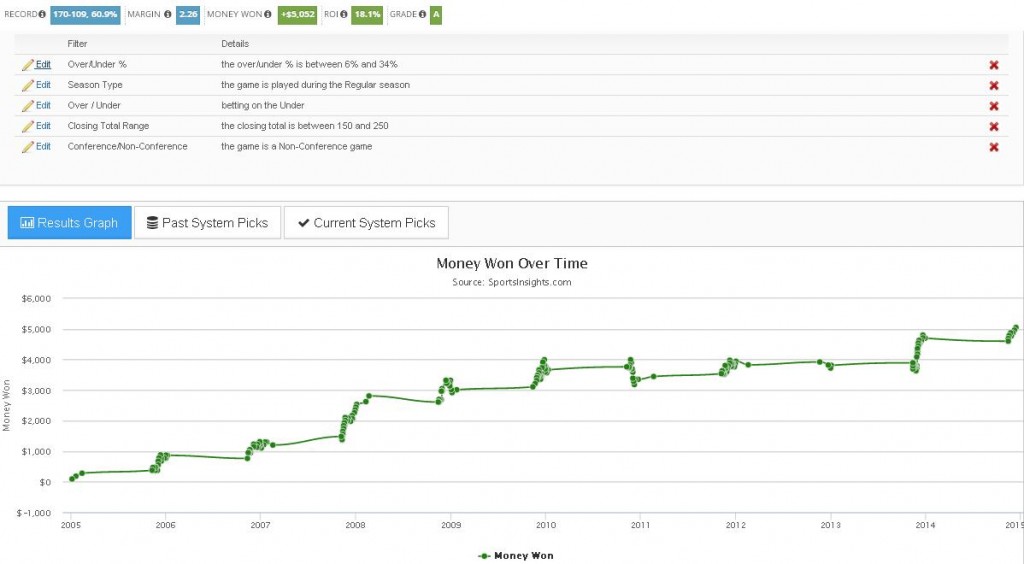
Betting Against the Public on High College Basketball Totals
Before the start of the season we published our 2014-15 College Basketball Betting Against the Public report which explained how bettors could capitalize on contrarian value by taking large road underdogs following a loss. However, one of the key components of this system stipulated that it must be a conference game as that familiarity disproportionately benefits the underdog. Since most teams don’t begin their conference schedule until the New Year, this system has had just one game match for the current season.
With limited action for our primary College Basketball betting system, we were curious whether bettors could also benefit from betting against the public on College Basketball totals. Traditionally, the public tends to prefer favorites and “overs” which makes sense when you consider that it is human nature to root for winners and high-scoring games. Sportsbooks understand this and shade their lines accordingly, which frequently creates value on underdogs and “unders.”
Using our Bet Labs software, we quickly confirmed that there has been a slight edge to betting on the under. Since 2005, the under has gone 14,895-14,595 (50.5%) which does not come close to covering the necessary 52.38% win percentage needed to cover the traditional -110 juice charged by most sportsbooks.
While simply betting every College Basketball under would not be profitable, we knew that we could improve our return on investment (ROI) by focusing on games with high totals. Historically the over has fared exceptionally well in games with low totals, while the under has been highly profitable in games with high totals. The logic behind this trend seems quite apparent as higher totals mean that more points must be scored to hit the over.
We found that over the past decade the average College Basketball total is 136.54 and the average total since the start of the 2013-14 season has been slightly higher at 140.03. Using this data, we defined a high total as any over/under of 150 or more and found that the under had gone 1,562-1,402 (52.7%) for +62.16 units earned with a 2.1% return on investment (ROI) in these matchups.
Also knowing that the lack of familiarity between teams playing in non-conference games typically leads to a low-scoring “feeling out” period, we were able to improve our system record to 665-531 (55.6%) with +91.61 units won and a 7.7% ROI. On the flip side, it’s actually been a losing strategy to bet these unders in conference showdowns.
Though this strategy was already profitable and offered the type of large sample size, driving hypothesis and consistent year-to-year results that we look for in a winning betting system, we wanted to know whether betting against the public could be used for further improvement.
Note: Our public betting percentages come from our seven contributing offshore sportsbooks and represent real bets placed by real bettors.
| Public Betting | Record (ATS) | Units Won | ROI |
|---|---|---|---|
| All | 562-434 | +91.89 | 9.2% |
| <50% | 331-250 | +60.20 | 10.4% |
| <40% | 215-148 | +54.16 | 14.9% |
| <35% | 170-109 | +50.52 | 18.1% |
| <25% | 53-31 | +18.21 | 21.7% |
It’s interesting to see that as we focus on games with more and more lopsided public betting percentages, we see a continually improved return on investment. Unfortunately, the sample size is very limited at the 25% threshold so we would advise bettors to focus on unders receiving less than 35% of public bets (170-109, +50.52 units won).
After producing a 27-16 record during the 2013-14 season, this betting system has gone 6-2 thus far this year. Current Bet Labs users are able to copy this system from our Think Tank to receive all current game matches.
Have any questions for the staff at Sports Insights? Utilize our live chat to speak with a customer service representative or e-mail us at help@sportsinsights.com.



Jamez
11/16/2015 at 3:31 amGreat article! I was wondering though, does this include March Madness? Thank you
David Solar
11/16/2015 at 12:25 pmIf you look at the screenshot of this system, you’ll see that it’s only based on regular season results. The record is only 19-20 during the postseason.